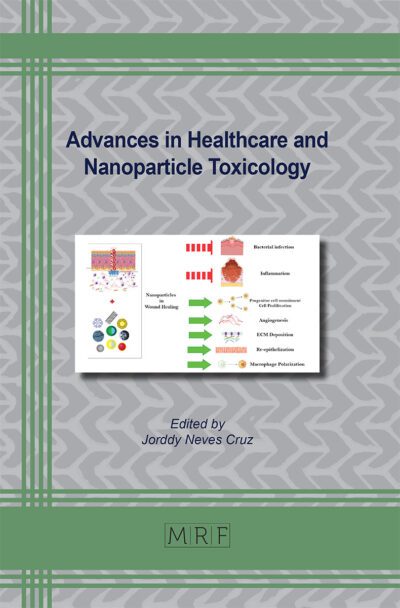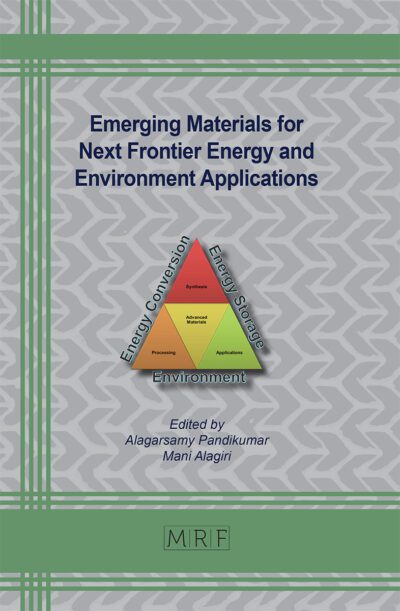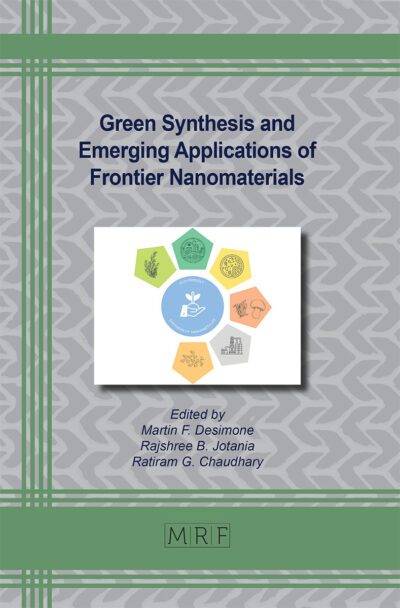Carbon Quantum Dot Composites for Photocatalytic Degradation of Organic Pollutants
G. Sharma, S. Sharma, A. Kumar, P. Dhiman, D. Jamwal, D. Rana, R.P. Dwivedi, G.T. Mola
In the present chapter, basic chemistry of carbon quantum dots (CQDs) has been presented. CQDs actually represent a class of materials comprising of carbon atoms in the nanometric range. These are more important as compared to other quantum dots. The CQDs can be synthesized using different methods such as hydrothermal treatment, microwave method, electrochemical and synthetic route, etc. CQDs are of immense importance due to their eco-friendly nature, easy availability and cost-effectiveness. Different composites based on CQDs have been synthesized in the recent years and being used for a number of applications such as biosensing, bioimaging, photocatalysis and chemical sensing, etc. CQDs based composites have been used as catalysts due to their outstanding electrochemical catalytic activity.
Keywords
Carbon Quantum Dots, Photocatalytic Degradation, Hydrothermal Treatment, Quantum Dots, Fluorescence
Published online 4/1/2018, 26 pages
DOI: https://dx.doi.org/10.21741/9781945291630-5
Part of Organic Pollutants in Wastewater I
References
[1] T. Yang, M. Lu, X. Mao, W. Liu, L. Wan, S. Miao, J. Xu, Synthesis of CdS quantum dots (QDs) via a hot-bubbling route and co-sensitized solar cells assembly, Chem. Eng. J. 225 (2013) 776-783. https://doi.org/10.1016/j.cej.2013.04.028
[2] Q. Xiao, S. Huang, W. Su, P. Li, J. Ma, F. Luo, J. Chen, Y. Liu, Y. Systematically investigations of conformation and thermodynamics of HSA adsorbed to different sizes of CdTe quantum dots, Colloids Surf. B: Biointerfaces 102 (2013) 76-82. https://doi.org/10.1016/j.colsurfb.2012.08.028
[3] V.K. Gupta, T.A. Saleh, D. Pathania, B.S. Rathore, G. Sharma, A cellulose acetate based nanocomposite for photocatalytic degradation of methylene blue dye under solar light, Ionics 21 (2015) 1787-1793. https://doi.org/10.1007/s11581-014-1323-9
[4] S.N. Baker, G.A. Baker, Luminescent Carbon Nanodots: Emergent Nano lights. Angew. Chem. Int. Ed. 49 (2010) 6726- 6744. https://doi.org/10.1002/anie.200906623
[5] Z. Yang, Z. Li, M. Xu, Y. Ma, J. Zhang, Y. Su, F. Gao, H. Wei, L. Zhang, Controllable Synthesis of Fluorescent Carbon Dots and Their Detection Application as Nanoprobes. Nano-Micro Letters 5 (2013) 247-259. https://doi.org/10.1007/BF03353756
[6] A. Fu, W. Gu, C. Larabell, A.P. Alivisatos, Semiconductor nanocrystals for biological imaging, Curr. Opin. Neurobio. 15 (2005) 568-575. https://doi.org/10.1016/j.conb.2005.08.004
[7] J.E. Halpert, V.J. Porter, J.P. Zimmer, M.G. Bawendi, Synthesis of CdSe/CdTe nanobarbells. J. Am. Chem. Soc. 128 (2006) 12590-12591. https://doi.org/10.1021/ja0616534
[8] P. Reiss, S. Carayon, J. Bleuse, A. Pron, Low polydispersity core/shell nanocrystals of CdSe/ ZnSe and CdSe/ZnSe/ZnS type: preparation and optical studies, Synth. Met. 139 (2003) 649- 652. https://doi.org/10.1016/S0379-6779(03)00335-7
[9] J. Chen, J.L. Song, X.W. Sun, W.Q. Deng, C.Y. Jiang, W. Lei, J.H. Huang, R.S. Liu, An oleic acid capped CdSe quantum-dot sensitized solar cell, Appl. Phys. Lett. 94 (2009) 153115(1-3). https://doi.org/10.1063/1.3117221
[10] P. Reiss, J. Bleuse, A. Pron, Highly luminescent CdSe/ZnSe core/shell nanocrystals of low size dispersion, Nano Lett. 2 (2002) 781-784. https://doi.org/10.1021/nl025596y
[11] Y. Jin-nouchi, T. Hattori, Y. Sumida, M. Fujishima, H. Tada, PbS quantum dot-sensitized photoelectrochemical cell for hydrogen production from water under illumination of simulated sunlight, Chemphyschem 11 (2010) 3592-3595. https://doi.org/10.1002/cphc.201000593
[12] Y. Tachibana, H.Y. Akiyama, Y. Ohtsuka, T. Torimoto, S. Kuwabata, CdS quantum dots sensitized TiO2 sandwich type photoelectrochemical solar cells, Chem. Lett. 36 (2007) 88-89. https://doi.org/10.1246/cl.2007.88
[13] Y. Song, D. Feng, W. Shi, X. Li, H. Ma, Parallel comparative studies on the toxic effects of unmodified CdTe quantum dots, gold nanoparticles, and carbon nanodots on live cells as well as green gram sprouts, Talanta 116 (2013) 237-244. https://doi.org/10.1016/j.talanta.2013.05.022
[14] Y. Liu, C.Y. Liu, Z.Y. Zhang, Synthesis and surface photochemistry of graphitized carbon quantum dots, J. Colloid Interface Sci. 356 (2011) 416-421. https://doi.org/10.1016/j.jcis.2011.01.065
[15] Y. Dong, N. Zhou, X. Lin, J. Lin, Y. Chi, G. Chen, Extraction of Electrochemiluminescent Oxidized Carbon Quantum Dots from Activated Carbon, Chem. Mater. 22 (2010) 5895-5899. https://doi.org/10.1021/cm1018844
[16] Y. Liu, Y.X. Yu, W.D. Zhang, Carbon quantum dots-doped CdS microspheres with enhanced photocatalytic performance, J. Alloys Compd. 569 (2013) 102-110. https://doi.org/10.1016/j.jallcom.2013.03.202
[17] Y.Q. Dong, C.Q. Chen, J.P. Lin, N.N. Zhou, Y.W. Chi, G.N. Chen, Electrochemiluminescence emission from carbon quantum dot-sulfite coreactant system, Carbon 56 (2013) 12-17. https://doi.org/10.1016/j.carbon.2012.12.086
[18] X. Zhang, H. Ming, R.H. Liu, X. Han, Z.H. Kang, Y. Liu, Y.L. Zhang, Highly sensitive humidity sensing properties of carbon quantum dots films, Mater. Res. Bull. 48 (2013) 790-794. https://doi.org/10.1016/j.materresbull.2012.11.056
[19] K. Hola, Y. Zhang, Y. Wang, E.P. Giannelis, R. Zboril, A.L. Rogach, Carbon dots—Emerging light emitters for bioimaging, cancer therapy and optoelectronics, Nano Today 9 (2014) 590-603. https://doi.org/10.1016/j.nantod.2014.09.004
[20] L. Cao, X. Wang, M.J. Meziani, F. Lu, H. Wang, P.G. Luo, Y. Lin, B.A. Harruff, L.M. Veca, D. Murray, S.Y. Xie, Carbon dots for multiphoton bioimaging, J. Am. Chem. Soc. 129 (2007) 11318-9. https://doi.org/10.1021/ja073527l
[21] H. Zhang, Y. Chen, M. Liang, L. Xu, S. Qi, H. Chen, X. Chen, Solid-phase synthesis of highly fluorescent nitrogen-doped carbon dots for sensitive and selective probing ferric ions in living cells, Anal. Chem. 86 (2014) 9846-52. https://doi.org/10.1021/ac502446m
[22] S.Y. Park, H.U. Lee, E.S. Park, S.C. Lee, J.W. Lee, S.W. Jeong, C.H. Kim, Y.C. Lee, Y.S. Huh, J. Lee, Photoluminescent green carbon nanodots from food-waste-derived sources: large-scale synthesis, properties, and biomedical applications, ACS Appl. Mater. Interfaces 6 (2014) 3365-70. https://doi.org/10.1021/am500159p
[23] S.L. Hu, K.Y. Niu, J. Sun, J. Yang, N.Q. Zhao, X.W. Du, One-step synthesis of fluorescent carbon nanoparticles by laser irradiation, J. Mater. Chem. 19 (2009) 484–488. https://doi.org/10.1039/B812943F
[24] H. Liu, T. Ye, C. Mao, Fluorescent carbon nanoparticles derived from candle soot, Angew. Chem. Int. Ed. 46 (2007) 6473–6475. https://doi.org/10.1002/anie.200701271
[25] L. Wang, S.J. Zhu, H.Y. Wang, S.N. Qu, Y.L. Zhang, J.H. Zhang, Q.D. Chen, H.L. Xu, W. Han, B. Yang, H.B. Sun, Common origin of green luminescence in carbon nanodots and graphene quantum dots, ACS Nano 8 (2014) 2541-2547. https://doi.org/10.1021/nn500368m
[26] H. Li, Z. Kang, Y. Liu, S.T. Lee, Carbon nanodots: synthesis, properties and applications, J. Mater. Chem. 22 (2012) 24230–24253. https://doi.org/10.1039/c2jm34690g
[27] X. Jia, J. Li, E. Wang, One-pot green synthesis of optically pH-sensitive carbon dots with upconversion luminescence, Nanoscale 4 (2012) 5572–5575. https://doi.org/10.1039/c2nr31319g
[28] V. Polshettiwar, M.N. Nadagouda, R.S. Varma, Microwave-assisted chemistry: A rapid and sustainable route to synthesis of organics and nanomaterials. Aust. J. Chem. 62 (2009) 16-26. https://doi.org/10.1071/CH08404
[29] X. Xu, R. Ray, Y. Gu, H.J. Ploehn, L. Gearheart, K. Raker, W.A. Scrivens, Electrophoretic analysis and purification of fluorescent single-walled carbon nanotube fragments, J. Am. Chem. Soc. 126 (2004) 12736-1227. https://doi.org/10.1021/ja040082h
[30] H. Jiang, F. Chen, M.G. Lagally, F.S. Denes, Newstrategy for synthesis and functionalization of carbon nanoparticles, Langmuir 26 (2010) 1991–1995. https://doi.org/10.1021/la9022163
[31] J. Zhou, C. Booker, R. Li, X. Zhou, T.K. Sham, X. Sun, Z. Ding, An electrochemical avenue to blue luminescent nanocrystals from multiwalled carbon nanotubes (MWCNTs), J. Am. Chem. Soc. 129 (2007) 744-745. https://doi.org/10.1021/ja0669070
[32] H.M.R. Gonc¸alves, A.J. Duarte, J.C.G. Esteves da Silva, Optical fiber sensor for Hg(II) based on carbon dots, Biosens. Bioelectron. 26 (2010) 1302–1306. https://doi.org/10.1016/j.bios.2010.07.018
[33] S. Hu, J. Liu, J. Yang, Y. Wang, S. Cao, Laser synthesis and size tailor of carbon quantum dots, J. Nanopart. Res. 13 (2011) 7247–7252. https://doi.org/10.1007/s11051-011-0638-y
[34] Y.P. Sun, B. Zhou, Y. Y. Lin, W. Wang, K.S. Fernando, P. Pathak, M.J. Meziani, B.A. Harruff, X. Wang, H. Wang, P.G. Luo, Quantum-sized carbon dots for bright and colorful photoluminescence, J. Am. Chem. Soc. 128 (2006) 7756–7757. https://doi.org/10.1021/ja062677d
[35] X. Zheng, A. Ananthanarayanan, Q. Luo, P. Chen, Glowing graphene quantum dots and carbon dots: properties, syntheses, and biological applications, Small 11 (2015) 1620-1636. https://doi.org/10.1002/smll.201402648
[36] K.A.S. Fernando, S. Sahu, Y. Liu, W.K. Lewis, E. Guliants, A. Jafariyan, P. Wang, C. Bunker, Y. Sun, Carbon quantum dots and applications in photocatalytic energy conversion, ACS Appl. Mater. Interfaces 7 (2015) 8363-8376. https://doi.org/10.1021/acsami.5b00448
[37] Q. Xiang, J. Yu, M. Jaroniec, Graphene-based semiconductor photocatalysts, Chem. Soc. Rev. 41 (2012) 782-796. https://doi.org/10.1039/C1CS15172J
[38] H. Li, X. He, Z. Kang, H. Huang, Y. Liu, J. Liu, S. Lian, C.H.A. Tsang, X. Yang, S.T. Lee, Water-soluble fluorescent carbon quantum dots and photocatalyst design, Angew. Chem. Int. Ed. 49 (2010) 4430–4434. https://doi.org/10.1002/anie.200906154
[39] H. Dong, A. Kuzmanoski, D. M.G¨oßl, R. Popescu, D. Gerthsen, C. Feldmann, Polyol-mediated C-dot formation showing efficient Tb3+/Eu3+ emission, Chem. Commun. 50 (2014) 7503–7506. https://doi.org/10.1039/C4CC01715C
[40] V.K. Gupta, G. Sharma, D. Pathania, N.C. Kothiyal, Nanocomposite pectin Zr(IV) selenotungstophosphate for adsorptional/photocatalytic remediation of methylene blue and malachite green dyes from aqueous system, J. Ind. Eng. Chem. Res. 21 (2014) 957-964. https://doi.org/10.1016/j.jiec.2014.05.001
[41] S.C. Ray, A. Saha, N.R. Jana, R. Sarkar, Fluorescent carbon nanoparticles: synthesis, characterization, and bioimaging application, J. Phys. Chem. C 113 (2009) 18546–18551. https://doi.org/10.1021/jp905912n
[42] G. Sharma, M. Naushad, A. Kumar, Shilpa, M.R. Khan, Lanthanum/cadmium/polyaniline bimetallic nanocomposite for the photodegradation of organic pollutant, Iran Polym. J. 24 (2015) 1003-1013. https://doi.org/10.1007/s13726-015-0388-2
[43] A.B. Bourlinos, A. Stassinopoulos, D. Anglos, R. Zboril, M. Karakassides, E.P. Giannelis, Surface functionalized carbogenic quantum dots, Small 4 (2008) 455–458. https://doi.org/10.1002/smll.200700578
[44] H. Zhu, X. Wang, Y. Li, Z. Wang, F. Yang, X. Yang, Microwave synthesis of fluorescent carbon nanoparticles with electrochemiluminescence properties, Chem. Commun. 34 (2009) 5118–5120. https://doi.org/10.1039/b907612c
[45] Q. Wang, X. Liu, L. Zhang, Y. Lv, Microwave-assisted synthesis of carbon nanodots through an eggshell membrane and their fluorescent application, The Analyst 137 (2012) 5392–5397. https://doi.org/10.1039/c2an36059d
[46] G.E. LeCroy, S.K. Sonkar, F. Yang, L.M. Veca, P. Wang, K.N. Tackett, J.J. Yu, E. Vasile, H. Qian, Y. Liu, P. Luo, Toward structurally defined carbon dots as ultracompact fluorescent probes, ACS Nano 8 (2014) 4522-9. https://doi.org/10.1021/nn406628s
[47] L. Tang, R. Ji, X. Cao, J. Lin, H. Jiang, X. Li, K.S. Teng, C.M. Luk, S. Zeng, J. Hao, S.P. Lau, Deep ultraviolet photoluminescence of water-soluble self-passivated graphene quantum dots, ACS Nano 6 (2012) 5102-10. https://doi.org/10.1021/nn300760g
[48] M.X. Gao, C.F. Liu, Z.L. Wu, Q.L. Zeng, X.X. Yang, W.B. Wu, Y.F. Li, C.Z. Huang, A surfactant-assisted redox hydrothermal route to prepare highly photoluminescent carbon quantum dots with aggregation-induced emission enhancement properties, Chem. Commun. 49 (2013) 8015-8017. https://doi.org/10.1039/c3cc44624g
[49] M. Xu, G. He, Z. Li, F. He, F. Gao, Y. Su, L. Zhang, Z. Yang, Y. Zhang, A green heterogeneous synthesis of N-doped carbon dots and their photoluminescence applications in solid and aqueous states, Nanoscale 6 (2014) 10307-10315. https://doi.org/10.1039/C4NR02792B
[50] D. Pathania, R. Katwal, G. Sharma, M. Naushad, M.R. Khan, A.H. Al-Muhtaseb, Novel guar gum/Al2O3 nanocomposite as an effective photocatalyst for the degradation of malachite green dye, Int. J. Biol. Macromol. 87 (2016) 366–374. https://doi.org/10.1016/j.ijbiomac.2016.02.073
[51] S. Chandra, P. Das, S. Bag, D. Laha, P. Pramanik, Synthesis, functionalization and bioimaging applications of highly fluorescent carbon nanoparticles, Nanoscale 3 (2011) 1533–1540. https://doi.org/10.1039/c0nr00735h
[52] V.K. Gupta, D. Pathania, T.A. Saleh, G. Sharma, Liquid phase synthesis of pectin–cadmium sulfide nanocomposite and its photocatalytic and antibacterial activity, J. Mol. Liq. 196 (2014) 107-112. https://doi.org/10.1016/j.molliq.2014.03.021
[53] Y. Hu, J. Yang, J. Tian, L. Jia, J.S. Yu, Waste frying oil as a precursor for one-step synthesis of sulfur-doped carbon dots with pH-sensitive photoluminescence, Carbon 77 (2014) 775–782. https://doi.org/10.1016/j.carbon.2014.05.081
[54] S.K. Bhunia, A.R. Maity, S. Nandi, D. Stepensky, R. Jelinek, Imaging cancer cells expressing the folate receptor with carbon dots produced from folic acid, Chem. Bio. Chem. 17 (2016) 614-619. https://doi.org/10.1002/cbic.201500694
[55] Z.C. Yang, M. Wang, A.M. Yong, S.Y. Wong, X.H. Zhang, H. Tan, A.Y. Chang, X. Li, J. Wang, Intrinsically fluorescent carbon dots with tunable emission derived from hydrothermal treatment of glucose in the presence of monopotassium phosphate, Chem. Commun. 47 (2011) 11615-11617. https://doi.org/10.1039/c1cc14860e
[56] W. Wang, Y.R. Ni, Z.Z. Xu, One-step uniformly hybrid carbon quantum dots with high-reactive TiO2 for photocatalytic application, J. Alloys Compd. 622 (2015) 303–308. https://doi.org/10.1016/j.jallcom.2014.10.076
[57] Y. Yang, J. Cui, M. Zheng, C. Hu, S. Tan, Y. Xiao, Q. Yang, Y. Liu, One-step synthesis of amino-functionalized fluorescent carbon nanoparticles by hydrothermal carbonization of chitosan, Chem. Commun. 48 (2012) 380-382. https://doi.org/10.1039/C1CC15678K
[58] S. Zhu, Q. Meng, L. Wang, J. Zhang, Y. Song, H. Jin, K. Zhang, H. Sun, H. Wang, B. Yang, Highly photoluminescent carbon dots for multicolor patterning, sensors, and bioimaging, Angew. Chem. Int. Ed. 52 (2013) 3953-3957. https://doi.org/10.1002/anie.201300519
[59] S. Liu, J. Tian, L. Wang, Y. Zhang, X. Qin, Y. Luo, A.M. Asiri, A.O. Al‐Youbi, X. Sun, Hydrothermal treatment of grass: A low‐cost, green route to nitrogen‐doped, carbon‐rich, photoluminescent polymer nanodots as an effective fluorescent sensing platform for label‐free detection of Cu(II) ions, Adv. Mater. 24 (2014) 2037-2041. https://doi.org/10.1002/adma.201200164
[60] H. Wu, C. Mi, H. Huang, B. Han, J. Li, S. Xu, Solvothermal synthesis of green-fluorescent carbon nanoparticles and their application, J. Lumin. 132 (2012) 1603-1607. https://doi.org/10.1016/j.jlumin.2011.12.077
[61] Z.A. Qiao, Y. Wang, Y. Gao, H. Li, T. Dai, Y. Liu, Q. Huo, Commercially activated carbon as the source for producing multicolor photoluminescent carbon dots by chemical oxidation, Chem. Commun. 46 (2010) 8812-8814. https://doi.org/10.1039/c0cc02724c
[62] J. Zhou, Z. Sheng, H. Han, M. Zou, C. Li, Facile synthesis of fluorescent carbon dots using watermelon peel as a carbon source, Mater. Lett. 66 (2012) 222-4. https://doi.org/10.1016/j.matlet.2011.08.081
[63] J. Wang, C.F. Wang, S. Chen, Amphiphilic egg‐derived carbon dots: Rapid plasma fabrication, pyrolysis process, and multicolor printing patterns, Angew. Chem. Int. Ed. 124 (2010) 9431-9435. https://doi.org/10.1002/ange.201204381
[64] J.R. Néabo, C. Vigier-Carrière, S. Rondeau-Gagné, J.F. Morin, Room-temperature synthesis of soluble, fluorescent carbon nanoparticles from organogel precursors, Chem. Commun. 48 (2012) 10144-10146. https://doi.org/10.1039/c2cc35087d
[65] S.L. Hu, K.Y. Niu, J. Sun, J. Yang, N.Q. Zhao, X.W. Du, One-step synthesis of fluorescent carbon nanoparticles by laser irradiation, J. Mater. Chem. 19 (2009) 484–488. https://doi.org/10.1039/B812943F
[66] H. Peng, J. Travas-Sejdic, Simple aqueous solution route to luminescent carbogenic dots fromcarbohydrates, Chem. Mater. 21 (2009) 5563–5565. https://doi.org/10.1021/cm901593y
[67] H.M. Goncalves, A.J. Duarte, J.C. da Silva, Optical fiber sensor for Hg(II) based on carbon dots, Biosens. Bioelectron. 26 (2010) 1302-1306. https://doi.org/10.1016/j.bios.2010.07.018
[68] S. Barman, M. Sadhukhan, Facile bulk production of highly blue fluorescent graphitic carbon nitride quantum dots and their application as highly selective and sensitive sensors for the detection of mercuric and iodide ions in aqueous media, J. Mater. Chem. 22 (2012) 21832-21837. https://doi.org/10.1039/c2jm35501a
[69] Y. Liu, C.Y. Liu, Z.Y. Zhang, Synthesis of highly luminescent graphitized carbon dots and the application in the Hg2+ detection, Appl. Surf. Sci. 263 (2012) 481-485. https://doi.org/10.1016/j.apsusc.2012.09.088
[70] F. Yan, Y. Zou, M. Wang, X. Mu, N. Yang, L. Chen, Highly photoluminescent carbon dots-based fluorescent chemosensors for sensitive and selective detection of mercury ions and application of imaging in living cells, Sens. Actuators, B 192 (2014) 488-495. https://doi.org/10.1016/j.snb.2013.11.041
[71] H. Huang, J.J. Lv, D.L. Zhou, N. Bao, Y. Xu, A.J. Wang, J.J. Feng, One-pot green synthesis of nitrogen-doped carbon nanoparticles as fluorescent probes for mercury ions, RSC Adv. 3 (2013) 21691-21696. https://doi.org/10.1039/c3ra43452d
[72] S.Y. Lim, W. Shen, Z. Gao, Carbon quantum dots and their applications, Chem. Soc. Rev. 44 (2015) 362-381. https://doi.org/10.1039/C4CS00269E
[73] H. Gonçalves, P.A. Jorge, J.R. Fernandes, J.C. da Silva, Hg (II) sensing based on functionalized carbon dots obtained by direct laser ablation, Sens. Actuators, B 145 (2010) 702-717. https://doi.org/10.1016/j.snb.2010.01.031
[74] A.S. Kumar, T. Ye, T. Takami, B.C. Yu, A.K. Flatt, J.M. Tour, P.S. Weiss, Reversible photo-switching of single azobenzene molecules in controlled nanoscale environments, Nano Letters 8 (2008) 1644-1648. https://doi.org/10.1021/nl080323+
[75] M. Zhang, Q. Wang, C. Chen, L. Zang, W. Ma, J. Zhao, Oxygen atom transfer in the photocatalytic oxidation of alcohols by TiO2: oxygen isotope studies, Angew. Chem. Int. Ed. 121 (2009) 6197-6200. https://doi.org/10.1002/ange.200900322
[76] Q. Wang, M. Zhang, C. Chen, W. Ma, J. Zhao, Photocatalytic aerobic oxidation of alcohols on TiO2: the acceleration effect of a Brønsted acid, Angew. Chem. Int. Ed. 49 (2010) 7976-7979. https://doi.org/10.1002/anie.201001533
[77] Y. Zhang, N. Zhang, Z.R. Tang, Y.J. Xu, Improving the photocatalytic performance of graphene–TiO 2 nanocomposites via a combined strategy of decreasing defects of graphene and increasing interfacial contact, Ber. Bunsen-Ges. Phys. Chem. 14 (2012) 9167-9175.
[78] H. Li, R. Liu, S. Lian, Y. Liu, H. Huang, Z. Kang, Near-infrared light controlled photocatalytic activity of carbon quantum dots for highly selective oxidation reaction, Nanoscale 5 (2013) 3289-3297. https://doi.org/10.1039/c3nr00092c
[79] Z. Ma, H. Ming, H. Huang, Y. Liu, Z. Kang, One-step ultrasonic synthesis of fluorescent N-doped carbon dots from glucose and their visible-light sensitive photocatalytic ability, New J. Chem. 36 (2012) 861-864. https://doi.org/10.1039/c2nj20942j
[80] S. Hu, R. Tian, Y. Dong, J. Yang, J. Liu, Q. Chang, Modulation and effects of surface groups on photoluminescence and photocatalytic activity of carbon dots, Nanoscale 5 (2013) 11665-11671. https://doi.org/10.1039/c3nr03893a
[81] S. Hu, R. Tian, L. Wu, Q. Zhao, J. Yang, J. Liu, S. Cao, Chemical regulation of carbon quantum dots from synthesis to photocatalytic activity, Chem. Asian J. 8 (2013) 1035-1041. https://doi.org/10.1002/asia.201300076
[82] H. Li, R. Liu, W. Kong, J. Liu, Y. Liu, L. Zhou, X. Zhang, S.T. Lee, Z. Kang, Carbon quantum dots with photo-generated proton property as efficient visible light controlled acid catalyst, Nanoscale 6 (2014) 867-873. https://doi.org/10.1039/C3NR03996J
[83] J. Di, J. Xia, Y. Ge, H. Li, H. Ji, H. Xu, Q. Zhang, H. Li, M. Li, Novel visible-light-driven CQDs/Bi 2 WO 6 hybrid materials with enhanced photocatalytic activity toward organic pollutants degradation and mechanism insight, Appl. Catal. B 168 (2015) 51-61. https://doi.org/10.1016/j.apcatb.2014.11.057
[84] X. Chen, S.S. Mao, Titanium dioxide nanomaterials: synthesis, properties, modifications, and applications, Chem. Rev. 107 (2007) 2891-2895. https://doi.org/10.1021/cr0500535
[85] Z. Kang, Y. Liu, C.H. Tsang, D.D. Ma, X. Fan, N.B. Wong, S.T. Lee, Water‐soluble silicon quantum dots with wavelength‐tunable photoluminescence, Adv. Mater. 21 (2009) 661-664. https://doi.org/10.1002/adma.200801642
[86] X. Zhang, F. Wang, H. Huang, H. Li, X. Han, Y. Liu, Z. Kang, Carbon quantum dot sensitized TiO2 nanotube arrays for photoelectrochemical hydrogen generation under visible light, Nanoscale 5 (2013) 2274– 2278. https://doi.org/10.1039/c3nr34142a
[87] V.N. Mehta, S. Jha, S. K. Kailasa, One-pot green synthesis of carbon dots by using Saccharum officinarum juice for fluorescent imaging of bacteria (Escherichia coli) andyeast (Saccharomyces cerevisiae) cells, Mater. Sci. Eng. C 38 (2014) 20–27. https://doi.org/10.1016/j.msec.2014.01.038
[88] S.T. Yang, L. Cao, P.G. Luo, F. Lu, X. Wang, H. Wang, M.J. Meziani, Y. Liu, G. Qi, Y.P. Sun, Carbon dots for optical imaging in vivo, J. Amer. Chem. Soc. 131 (2009) 11308–11309. https://doi.org/10.1021/ja904843x
[89] R. Liu, D. Wu, S. Liu, K. Koynov, W. Knoll, Q. Li, An aqueous route to multicolor photoluminescent carbon dots using silica spheres as carriers, Angew. Chem. Int. Ed. 121 (2009) 4668-4671. https://doi.org/10.1002/ange.200900652
[90] S.C. Ray, A. Saha, N.R. Jana, R. Sarkar, Fluorescent carbon nanoparticles: synthesis, characterization, and bioimaging application, J. Phys. Chem. 113 (2009) 18546-18551. https://doi.org/10.1021/jp905912n
[91] S. Sahu, B. Behera, T.K. Maiti, S. Mohapatra, Simple one-step synthesis of highly luminescent carbon dots from orange juice: application as excellent bio-imaging agents, Chem. Commun. 48 (2012) 8835-8837. https://doi.org/10.1039/c2cc33796g
[92] V.N. Mehta, S. Jha, S.K. Kailasa, One-pot green synthesis of carbon dots by using Saccharum officinarum juice for fluorescent imaging of bacteria (Escherichia coli) and yeast (Saccharomyces cerevisiae) cells, Mater. Sci. Eng. C 38 (2014) 20-27. https://doi.org/10.1016/j.msec.2014.01.038
[93] Q. Liang, W. Ma, Y. Shi, Z. Li, X. Yang, Easy synthesis of highly fluorescent carbon quantum dots from gelatin and their luminescent properties and applications, Carbon 60 (2013) 421-428. https://doi.org/10.1016/j.carbon.2013.04.055
[94] D. Sun, R. Ban, P.H. Zhang, G.H. Wu, J.R. Zhang, J.J. Zhu, Hair fiber as a precursor for synthesizing of sulfur-and nitrogen-co-doped carbon dots with tunable luminescence properties, Carbon 64 (2013) 424-434. https://doi.org/10.1016/j.carbon.2013.07.095
[95] Y. Xu, M. Wu, Y. Liu, X.Z. Feng, X.B. Yin, X.W. He, Y.K. Zhang, Nitrogen‐doped carbon dots: A facile and general preparation method, Photoluminescence investigation, and imaging applications, Chem. Eur. J. 19 (2013) 2276-2283. https://doi.org/10.1002/chem.201203641
[96] P. Miao, K. Han, Y. Tang, B. Wang, T. Lin, W. Cheng, Recent advances in carbon nanodots: synthesis, properties and biomedical applications, Nanoscale 7 (2015) 1586-1595. https://doi.org/10.1039/C4NR05712K
[97] H. Peng, J. Travas-Sejdic, Simple aqueous solution route to luminescent carbogenic dots from carbohydrates, Chem. Mater. 21 (2009) 5563-5565. https://doi.org/10.1021/cm901593y
[98] D. Chowdhury, N. Gogoi, G. Majumdar, Fluorescent carbon dots obtained from chitosan gel, RSC Adv. 2 (2012) 12156-12159. https://doi.org/10.1039/c2ra21705h
[99] C.W. Lai, Y.H. Hsiao, Y.K. Peng, P.T. Chou, Facile synthesis of highly emissive carbon dots from pyrolysis of glycerol; gram scale production of carbon dots/mSiO2 for cell imaging and drug release, J. Mater. Chem. 22 (2012) 14403–14409. https://doi.org/10.1039/c2jm32206d
[100] D. Pathania, D. Gupta, A.H. Al-Muhtaseb, G. Sharma, A. Kumar, M. Naushad, T. Ahamad, S.M. Alshehri, Photocatalytic degradation of highly toxic dyes using chitosan-g-poly(acrylamide)/ZnS in presence of solar irradiation, J. Photochem. Photobiol. A 329 (2016) 61-68. https://doi.org/10.1016/j.jphotochem.2016.06.019
[101] B.Y. Yu, S.Y. Kwak, Carbon quantum dots embedded with mesoporous hematite nanospheres as efficient visible light-active photocatalysts, J. Mater. Chem. 22 (2012) 8345- 8353. https://doi.org/10.1039/c2jm16931b
[102] R. Xie, L. Zhang, H. Xu, Y. Zhong, X. Sui, Z. Mao, Construction of up-converting fluorescent carbon quantum dots/Bi20TiO32 composites with enhanced photocatalytic properties under visible light, Chem. Eng. J. 310 (2017) 79–90. https://doi.org/10.1016/j.cej.2016.10.089
[103] S. Muthulingam, I.H. Lee, P. Uthirakumar, Highly efficient degradation of dyes by carbon quantum dots/N-doped zinc oxide(CQD/N-ZnO) photocatalyst and its compatibility on three different commercial dyes under day light, J. Colloid Interface Sci. 455 (2015) 101–109. https://doi.org/10.1016/j.jcis.2015.05.046












